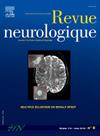抗 IgLON5 疾病的临床表现和抗体机制。
IF 2.8
4区 医学
Q2 CLINICAL NEUROLOGY
引用次数: 0
摘要
抗 IgLON5 病是一种罕见的神经系统疾病,十年前才被发现,是自身免疫和神经变性的结合。这种疾病的症状多种多样,有时会模仿纯粹的神经退行性疾病或运动神经元疾病,再加上人们对这种疾病缺乏认识,因此给诊断带来了挑战。神经元损伤的生物标志物与正电子发射断层扫描(PET)对 tau 沉积的活体可视化相结合,可在监测疾病进展方面取得重大进展。最近的研究获得了更多的尸体解剖,有助于完善对该病病理特征的认识,并加强了该病的自身免疫假说。尽管抗 IgLON5 病的发病机制仍不清楚,但最近发表的研究结果表明,抗体介导的细胞表面 IgLON5 簇的不可逆减少和细胞骨架的改变,以及在通过被动转移输注患者抗体的动物大脑中观察到的行为异常、神经炎症和神经变性迹象,都支持该病的自身免疫假说。本综述旨在总结抗IgLON5疾病病理生理学的这些重要方面和最新进展。本文章由计算机程序翻译,如有差异,请以英文原文为准。
Clinical presentations and antibody mechanisms in anti-IgLON5 disease
Anti-IgLON5 disease is a rare neurological disease, identified just ten years ago, where autoimmunity and neurodegeneration converge. The heterogeneity of symptoms, sometimes mimicking pure neurodegenerative diseases or motor neuron diseases, in addition to lack of awareness, represents a diagnostic challenge. Biomarkers of neuronal damage in combination with in vivo visualization of tau deposition using positron emission tomography (PET) scanning could represent a major advance in monitoring disease progression. Recent studies with more autopsies available have helped refine the knowledge of the pathological features of the disease and strengthen the autoimmune hypothesis of the disease. Although the pathogenesis of anti-IgLON5 disease remains unclear, the irreversible antibody-mediated decrease of IgLON5 clusters from the cell surface and alterations produced in the cytoskeleton, as well as the behavioural abnormalities and signs of neuroinflammation and neurodegeneration observed in the brains of animals infused with antibodies from patients by passive transfer, which have recently been published, support the autoimmune hypothesis of the disease. This review aims to summarize these important aspects and recent advances in the pathophysiology of anti-IgLON5 disease.
求助全文
通过发布文献求助,成功后即可免费获取论文全文。
去求助
来源期刊

Revue neurologique
医学-临床神经学
CiteScore
4.80
自引率
0.00%
发文量
598
审稿时长
55 days
期刊介绍:
The first issue of the Revue Neurologique, featuring an original article by Jean-Martin Charcot, was published on February 28th, 1893. Six years later, the French Society of Neurology (SFN) adopted this journal as its official publication in the year of its foundation, 1899.
The Revue Neurologique was published throughout the 20th century without interruption and is indexed in all international databases (including Current Contents, Pubmed, Scopus). Ten annual issues provide original peer-reviewed clinical and research articles, and review articles giving up-to-date insights in all areas of neurology. The Revue Neurologique also publishes guidelines and recommendations.
The Revue Neurologique publishes original articles, brief reports, general reviews, editorials, and letters to the editor as well as correspondence concerning articles previously published in the journal in the correspondence column.
 求助内容:
求助内容: 应助结果提醒方式:
应助结果提醒方式:


